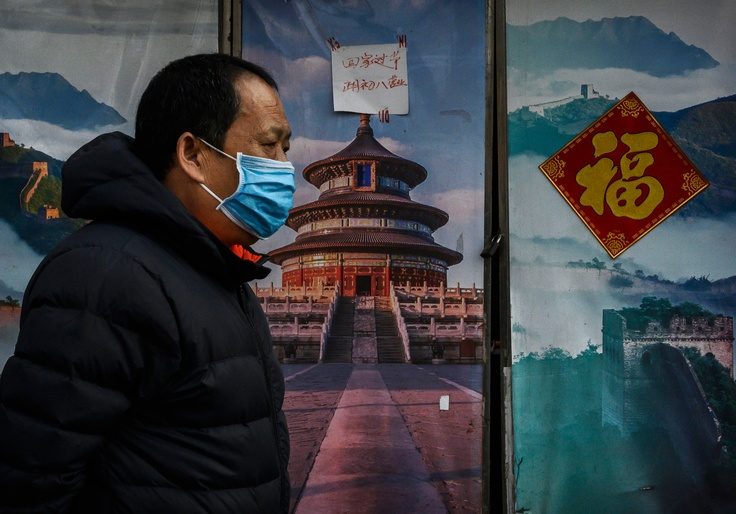China has accused U.S. leaders of racism for referring to the new coronavirus as the "Wuhan virus." But an examination of Chinese state-media reporters shows the term was used frequently in their coverage during the initial stages of the outbreak.
A March 8 report from the government-backed Global Times, for example, condemned Secretary of State Mike Pompeo's use of the term, arguing that it was a "rude and vicious comment" and "a new low in his personal conduct." But Chinese state-media outlets routinely referred to the pathogen as the "Wuhan virus" or "Wuhan pneumonia" through mid-February.
"Wuhan pneumonia a wakeup call for basic Chinese research," read the headline for a Jan. 22 piece published by Global Times, the same outlet that criticized Pompeo. "China, where both SARS and the Wuhan virus first emerged, failed to be the first in relevant diagnostic research and development (R&D) in both cases."
State-media outlets adopted new names for the pathogen just as China launched a global propaganda campaign to deflect responsibility for the pandemic. The world-spanning media blitz, involving both state media and ambassadors, argued that China's successful response bought time for the rest of the world—a talking point regurgitated by the New York Times on March 12. The propaganda effort also seeks to minimize the botched response of the Wuhan and Chinese authorities, in part by blaming the U.S. military for the outbreak without any evidence.
Despite the triumphant claims of propagandists, Chinese authorities exacerbated the pandemic by attempting to keep it under wraps for weeks after the first coronavirus case emerged in December. China's failed cover-up wasted precious time during the early days of the pandemic. One study found that coronavirus cases could have been reduce by 95 percent if China started its response three weeks earlier.
On February 11, the World Health Organization (WHO) and the International Committee on Taxonomy of Viruses officially named the new pathogen SARS-CoV-2, and the disease it causes as COVID-19, which stands for Corona Virus Disease. But before that date, media outlets across the world used a variety of different names to refer to the new pathogen, including Wuhan, the Chinese city where the disease was first observed.
For example, a Jan. 9 article published by the Xinhua News Agency, a state-propaganda organ, labeled the new disease "Wuhan's viral pneumonia epidemic with unknown causes" in a Chinese-language article. People's Daily, the official party paper of the Chinese Communist Party, reported that the "fourth death [was] confirmed in Wuhan pneumonia cases" on Jan. 21. Global Times also published an article on Jan. 25 in English, calling the disease the "Wuhan pneumonia."
None of those outlets returned requests for comment.
The propaganda outlets stopped including references to Wuhan in their Chinese-language publications around the end of January, with one Jan. 29 Xinhua editorial arguing that the term "Wuhan pneumonia" is "prejudiced" and disrespectful to the city's residents. By February, editors started applying the same standards for English-language articles: One Xinhua opinion column from Feb. 12 requested Western journalists to "quit racist reporting" and refrain from calling the virus the "Chinese virus" or the "Wuhan virus."
But the new editorial standard took some time to permeate across all Chinese propaganda outlets, especially those that publish in English. After Global Times condemned Western outlets for using the term "Wuhan virus" on Feb. 6, it published a new article two weeks later featuring the prohibited term. "Chinese netizens fear Japan would repeat Wuhan virus mistake at early stage," read the headline for a Global Times piece published on Feb. 17.
The naming conventions used by U.S. media outlets have also evolved over time. As recently as Feb. 3, when the virus was mainly hammering mainland China, the Associated Press issued a guideline encouraging journalists to refer to the new pathogen as "'the new virus from China,' 'the new virus,' 'the coronavirus from China,' etc." on first reference.
After WHO granted the virus its official name and China condemned references linking the outbreak to China, AP revised its coronavirus guideline by dropping any mention of China. Now, the wire service recommends that journalists use "the new coronavirus," "the new virus," or "COVID-19." As a result, many media outlets that previously referred to the virus as the Wuhan virus or the Chinese virus are condemning President Donald Trump for doing the same.
WHO has also asked people to refrain from using the term SARS-CoV-2 to talk about the pandemic because the term SARS might "create unnecessary fear for some population, especially in Asia." The new coronavirus is related to but not the same as the pathogen that caused the 2003 outbreak.
In the past, WHO has recognized several diseases that explicitly reference the disease's origins or initial outbreak site. For instance, contagion-caused diseases such as the Middle East Respiratory Syndrome (MERS) first started in Saudi Arabia, and the Crimean-Congo Haemorrhagic Fever refers to the two locations where the disease was first found.
